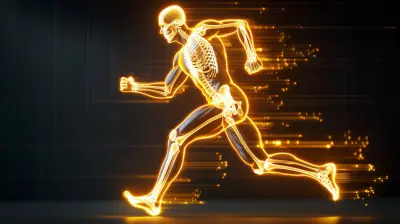Building an Unstoppable Mind-Muscle Connection
21 May 2025
When it comes to building strength and muscle, most people focus on lifting heavier weights or increasing reps. But have you ever heard of the mind-muscle connection? This underrated technique could be the missing piece in your fitness journey.
If you've ever gone through a workout feeling disconnected from your muscles—just going through the motions—you're not alone. The mind-muscle connection is all about engaging your muscles intentionally, leading to better muscle activation, improved performance, and faster gains.
In this article, we'll dive deep into how you can build an unstoppable mind-muscle connection, unlock your full strength potential, and maximize every rep you perform. 
What Is the Mind-Muscle Connection?
In simple terms, the mind-muscle connection (MMC) is the ability to focus your mind on the muscle you’re working, ensuring maximum engagement during an exercise. Instead of just moving the weight, you consciously contract the muscle, making each rep more effective.Think of it like this: Imagine you’re trying to bend a garden hose while water is flowing through it. If you only push the hose without focusing on bending it at a specific point, the water keeps flowing freely. But if you intentionally pinch the hose, you control the flow. That’s exactly how focusing on your muscles works—with greater intention, you control muscle activation more effectively.
How Does It Work?
The mind-muscle connection works by enhancing neuromuscular communication—the way your brain sends signals to your muscles. When you focus mentally on a specific muscle group, your nervous system activates more muscle fibers, leading to:- Better muscle engagement
- Increased muscle hypertrophy (growth)
- Improved strength output
- Reduced risk of injury from improper form
The stronger your mind-muscle connection, the more efficiently your body recruits the right muscle fibers, leading to better results over time. 
Why Is the Mind-Muscle Connection Important?
Many people lift weights without engaging the right muscles. For example, during a bench press, you might feel your shoulders and triceps working more than your chest. This is a huge missed opportunity because you're not fully activating the target muscle group.Building a strong mind-muscle connection comes with several benefits:
1. Maximizes Muscle Growth
Studies show that focusing on contracting a muscle increases its activation levels, leading to greater muscle growth over time. If you're not mentally engaged, you're leaving gains on the table.2. Enhances Workout Efficiency
Rather than just moving the weight up and down, you make every rep count. This means fewer wasted reps and better results in a shorter time.3. Prevents Injuries
When you're not properly activating the right muscles, secondary muscles can take over, leading to imbalances and injuries. Engaging the correct muscle groups helps maintain proper form and reduces strain on joints.4. Improves Strength & Performance
Stronger neuromuscular communication means better control over your lifts, leading to increased strength over time. If you want to lift heavier, increasing your mind-muscle connection can help.
How to Build an Unstoppable Mind-Muscle Connection
Now that you understand the power of the mind-muscle connection, let's break down actionable steps you can take to improve it.1. Slow Down Your Reps
One of the biggest mistakes people make is rushing through their exercises. By slowing down the movement, you force your muscles to work harder instead of relying on momentum. Try tempo training, where you slow down the eccentric (lowering) phase of the lift.2. Use Lighter Weights
Lifting heavy is great, but sometimes ego lifting gets in the way of proper muscle engagement. Lower the weight slightly and focus purely on the contraction of the muscle. You’ll feel the difference almost immediately.3. Visualize the Movement
Before performing an exercise, close your eyes and visualize the muscle contracting. Studies show that mental imagery can significantly enhance neuromuscular activation.4. Touch the Muscle
Physically touching or tapping the muscle you’re working on can help build a better connection. For example, during bicep curls, lightly touching your biceps can remind you to keep the tension there.5. Flex and Squeeze
At the top of each rep, hold the contraction for 1-2 seconds and focus on squeezing the muscle as hard as possible. This helps reinforce the connection between your brain and the muscle fibers.6. Eliminate Distractions
Ditch the phone scrolling between sets. If you're distracted, your focus shifts, weakening the connection. Stay present, concentrate, and engage fully in your reps.7. Perform Isolation Exercises
Compound movements are essential for strength, but isolation exercises (like bicep curls, leg extensions, and lateral raises) allow you to hone in on specific muscles, reinforcing the mind-muscle connection.8. Use Resistance Bands
Resistance bands provide constant tension throughout the entire range of motion, forcing you to stay engaged and activate stabilizer muscles. This is a game-changer for reinforcing the connection.9. Incorporate Paused Reps
Instead of rushing through an exercise, hold the movement at the most challenging part for a second or two. Paused squats, bench presses, or even bicep curls increase time under tension, strengthening your control.10. Breathe Correctly
Proper breathing enhances oxygen flow to muscles, improving endurance and maintaining focus. Try exhaling during the contraction phase and inhaling on the eccentric (lowering) phase.
Mind-Muscle Connection for Different Muscle Groups
To master the mind-muscle connection, it's helpful to know how to engage specific muscles properly. Here are some quick activation cues:- Chest: Focus on "squeezing" your pecs together as if you're hugging a tree.
- Back: Think about "pulling with your elbows" rather than your hands.
- Shoulders: Control the movement and avoid using momentum—imagine reaching outward rather than just lifting.
- Biceps: Picture your biceps shortening and squeezing, rather than just curling the weight up.
- Triceps: Drive your hands downward vigorously in exercises like tricep pushdowns.
- Legs: Focus on pushing through the heels during squats and leg presses for maximum quad and glute activation.
Final Thoughts
The mind-muscle connection is one of the most powerful (yet overlooked) tools for muscle growth, strength development, and injury prevention. If you've been struggling to build muscle despite training hard, it might be time to train smarter by implementing these techniques.Remember, lifting heavy isn’t always the key—lifting with intention and focus is. Start applying these tips in your workouts, and you’ll soon notice a significant boost in both performance and muscle growth.
Now, time to hit the gym and make every rep count!
all images in this post were generated using AI tools
Category:
BodybuildingAuthor:

Laura Hudson
Discussion
rate this article
3 comments
Ziva Alvarez
Strengthen your mind; it empowers your body’s potential!
June 11, 2025 at 4:57 PM

Laura Hudson
Absolutely! A strong mind fuels physical strength, enhancing our overall potential. Let's unlock that power together!
Elise McInnes
This article beautifully highlights the vital role of the mind-muscle connection in achieving fitness goals. Understanding and nurturing this connection can truly elevate our performance and enhance results. Thank you for sharing such valuable insights!
May 30, 2025 at 3:55 AM

Laura Hudson
Thank you for your thoughtful comment! I'm glad you found the insights on the mind-muscle connection valuable for enhancing performance. Happy training!
Erica McCollum
Building a strong mind-muscle connection is essential for optimizing workouts. Focused concentration enhances muscle activation, leading to improved strength and performance. Prioritize awareness and intentionality for maximum training benefits.
May 22, 2025 at 3:12 AM

Laura Hudson
Absolutely! A strong mind-muscle connection amplifies workout effectiveness by enhancing muscle activation and performance. Prioritizing focus and intentionality is key to unlocking your training potential.



